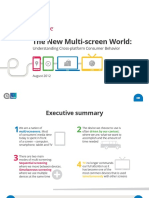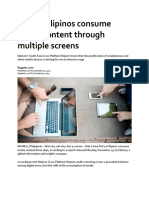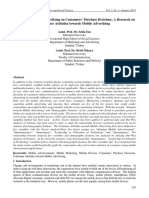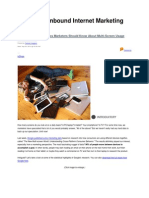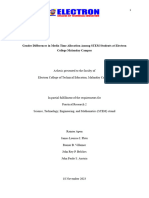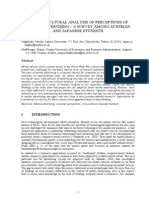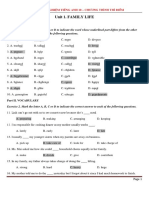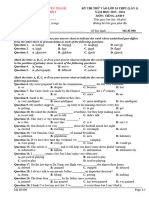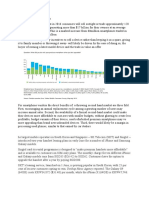RESEARCH
REPORT
Cross Screen User
Behavior Insights
Asia 2H 2015
�Executive Summary
Multi device usage is the norm for Asia.
The post-mobile era: instead of a one way shift from PC to mobile, our data shows that people continue to use all of
their screens in interconnected ways
As devices proliferate, peoples behavior across screens and across markets is increasingly complex--and increasingly
difficult to predict
People interact with ads differently across screens, and prefer different ad formats depending on the size of the
screen theyre using.
For advertisers hoping to reach consumers online, the data shows that cross screen is no longer optional.
�Multi device usage in Asia is the norm
�Multi device usage in Asia, 2H 2015
Over half of Asias multi
device users use three or
more screens.
More than one half of multi device
users in Asia use three or more
screens: 29% use three, while 22%
use four.
Y-axis: % of multi-device users
�Multi device usage in Asia, 2H 2015
Among markets we surveyed,
more than half reflect the
same trend
In AU, JP, KR, PH, SG and TW, more
than 50% of multi device users
switch between more three or
more screens.
Y-axis: % of multi-device users
�The post mobile era:
device numbers and usage in Asia Pacific
�Number of reachable unique devices in Asia by day of week
The number of mobile
phones far surpasses tablets
and PCs
Unique reachable devices
represents the number of actual
devices powered on and connected
to the internet online: the total
pool of unique devices Appier can
reach on a given day.
On weekdays, for every one active
PC there are 6.4 mobiles (1:7.8 on
weekends). For every tablet
reachable on weekdays, there are
17.2 reachable mobiles (1:16 on
weekends).
Y-axis: Number of unique devices
�Device usage in Asia by day of week and device type
PC punches above its weight
in usage
PC generates more than 50% of the
volume of usage as smartphones
despite representing only a tiny
fraction of the total unique
reachable devices.
Tablets also generate a
disproportionate amount of usage.
Y-axis: Number of ad requests
�Ad requests on unique devices in Asia by day of week
PC also punches above its
weight in average usage per
device
Looking at ad requests on unique
devices helps estimate the average
volume of usage per individual
device.
Each individual PC is used nearly 4
times as much as each individual
smartphone. Each tablet also
generates 20%-30% more average
usage than smartphones.
Y-axis: Number of ad requests on unique devices
�Number of reachable unique smartphones by day of week in Asia
HK
JP
ID
MY
Number of reachable unique
smartphones by day of week
SG
TW
Around the region, the number of
unique reachable smartphones
tends to peak Mondays, with the
exception of Indonesia and
Malaysia.
Y-axis: Number of unique devices
VN
�Number of reachable unique tablets by day of week in Asia
HK
JP
ID
MY
Number of reachable unique
tablets by day of week
SG
TW
On the other hand, for most of
Asia, unique reachable tablets
peak on Sundays as people enjoy
their weekend at home.
Y-axis: Number of unique devices
VN
�Number of reachable unique PCs by day of week in Asia
HK
JP
ID
MY
Number of reachable unique
PCs by day of week
SG
TW
As expected, the number of
unique reachable PCs drops as
the weekend approaches and
office workers shut down their
PCs.
Y-axis: Number of unique devices
VN
�Smartphone usage by day of week in Asia
HK
JP
ID
MY
Smartphone usage by
day of week
Across Asia, smartphone usage
peaks vary across the region, from
midweek in HK and ID to weekend
in JP, TW and MY to Monday in SG.
SG
TW
Y-axis: Number of ad requests
VN
�Tablet usage by day of week in Asia
HK
JP
ID
MY
Tablet usage by
day of week
Tablet tends to see heaviest usage
on weekends.
SG
TW
Y-axis: Number of ad requests
VN
�PC usage by day of week in Asia
HK
JP
ID
MY
PC usage by day of week
PC usage tends to be lowest on
weekends in most markets across
the region.
SG
TW
Y-axis: Number of ad requests
VN
�Ad requests on unique smartphones by day of week in Asia
HK
JP
ID
MY
Average usage per device by
day of week, smartphone
SG
TW
VN
Average usage per smartphone
remains fairly consistent across
the region throughout the week,
with minor peaks varying market
by market.
Y-axis: Number of ad requests on unique smartphones
�Ad requests on unique tablets by day of week in Asia
HK
JP
ID
MY
Average usage per device by
day of week, tablet
SG
TW
VN
Average usage per tablet rises on
weekends in most markets across
Asia, with the exception of VN, ID and
MY.
Y-axis: Number of ad requests on unique tablets
�Ad requests on unique PCs by day of week in Asia
HK
JP
ID
MY
Average usage per device by
day of week, PC
Average usage per PC varies
across the region. In aspiring
markets where PC is primarily
used in the workplace, average
usage per PC peaks on weekdays.
In developed markets where many
households own PCs, average
usage per PC tends to rise on
weekends.
SG
TW
VN
Y-axis: Number of ad requests on unique PCs
�As devices proliferate, peoples behavior across
screens and across markets is increasingly
complex--and increasingly difficult to predict
�PC usage in Asia by gender and day of the week
Men in Asia are 3% more
active on PC than women as
measured by average
individual usage
Men and womens usage patterns
also diverge; on average across
the region, womens usage of PC
peaks on Thursdays, whereas
mens peaks on Saturdays.
Exceptions include: ID (Thurs for
both men and women), SG and
TW (Sun for both genders), and JP
(Sat for both genders)
Y-axis: Number of ad requests on unique PCs
�Smartphone usage in Asia by gender and day of the week
Men are also more active on
smartphone
The average mans individual
usage exceeds that of womens
by 4%.
Y-axis: Number of ad requests on unique smartphones
�Tablet usage in Asia by gender and day of the week
However, women are
significantly more active on
tablet than men
Women are 14% more active on
average across the region. At the
same time, there are differences
market by market in the usage
patterns between men and
women by day of the week.
Y-axis: Number of ad requests on unique tablets
�PC, mobile and tablet web
usage patterns by time of day
As measured by device cookies,
PC and mobile usage intersects
frequently during the workday
(8AM-5PM).
Smartphone usage outpaces PC
during lunchtime (12-2PM) and
again as people leave the office
beginning at 5PM.
Tablet usage remains low during
the workday but begins
accelerating after 5PM. Usage on
all three devices peaks at 11PM.
PC, smartphone and tablet web usage by time of day
�People interact with ads differently across screens,
and prefer different ad formats depending on the
size of the screen theyre using
�Across Asia, over one third of
cross screen users interact
completely differently with
ads across different screens
Users exhibiting different behaviors to online ads
across devices in Asia (0% similarity vs. 100% similarity)
Some cross screen users tend to
interact with advertising the same
way--clicking on the same types of
ads for the same products or
services regardless of the screen
theyre using at the time. Others
exhibit different behaviors
depending on the screen, using
different screens for different
purposes or favoring certain ad
formats or subject matter on
different screens.
Just under one third interact with
advertising in the same manner
regardless of the device theyre
using. The remainder fall
somewhere in between--they share
some ad browsing habits across
screens, but not all of them.
X-axis: % of similarity ;Y-axis: % of cross screen users
�Cross screen users in certain
countries--such as VN, SG,
and TW--tend to exhibit
completely different
behaviors when interacting
with ads on different screens,
at rates higher than the
regional average.
Users exhibiting different behaviors to online ads
across devices (0% similarity)
In others, such as JP, ID and HK,
users tend to appear more similar
than the regional average.
X-axis: % of similarity ;Y-axis: % of cross screen users
�Percentage of users with 100% similarity to
online ads across devices
The vast majority of users in
HK and JP interact similarly
with ads across screens.
The opposite is true in SG, TW and
VN.
X-axis: % of similarity ;Y-axis: % of cross screen users
�Cross screen usage ebbs and
flows throughout the day
PC web usage patterns vs. conversion patterns
in Asia by time of day
We mapped daily screen usage
patterns against conversion
patterns--defined as an action
completed to our advertisers
specification, here including clicks
or completed video views. This
allows us to contrast daily PC
usage patterns with daily PC
conversion patterns. The result
suggests that certain times of day
produce more optimal
performance for online
advertising.
Conversion rates are relatively
higher during the workday
(roughly 8AM-6PM), and also
display a dramatic increase
between 11PM to 12AM--after
peak usage at 11PM.
Y-axis, left: number of device cookes. Y-axis, right: number of conversions
�In contrast to PC, smartphones
usage and conversion patterns
dont produce dramatic spikes.
Smartphone web usage patterns vs.
conversion patterns in Asia by time of day
Conversions peak early in the
evening at 7PM and taper off
gradually until midnight. In
contrast, usage picks up steadily
starting at 4PM, peaking at 11PM.
This suggests that while usage is
highest on smartphone at night
time, its not the most optimal time
to reach users on this screen-especially considering that PC
conversions are at their highest
peak at this time.
Y-axis, left: number of device cookes. Y-axis, right: number of conversions
�Tablet web usage patterns vs. conversion
patterns in Asia by time of day
Tablet shows a discrepancy
between peak usage and peak
conversion rate similar to that
on smartphone.
Tablet usage peaks at 11pm, while
conversion rate begins rising
during the day to peak at 9PM.
This suggests that as with
smartphone, users are relatively
more responsive to advertising on
tablet during the day and early
evening.
Y-axis, left: number of device cookes. Y-axis, right: number of conversions
�For advertisers hoping to reach consumers online,
the data shows that cross screen is no
longer optional
�Conversions: multi device vs cross screen
Cross screen is no
longer optional
Our data shows that cross screen
campaigns on average outperform
multi device campaigns by 26% (as
measured by conversion rate).
Y-axis: % of conversions
�Conversions: single vs cross screen
When compared to single
screen campaigns, the
difference is even more stark
Cross screen campaigns
outperform PC-, tablet-, and
mobile-only campaigns by a
significant margin.
Y-axis: % of conversions
�Takeaways for Marketers
Mobile first doesnt mean
mobile only.
Asia is famously mobile first:
many users are coming online
for the first time on mobile. But
our report shows its too early to
write off PC, which still plays a
significant role across the
region. In fact, cross screen
campaigns outperform single
screen campaigns by a
significant margin.
Put the user at the center.
A person who uses a PC, a tablet
and a smartphone is one person,
not three. Marketers need to
account for a number of
variables from personal
preference to habit and
convenience when reaching
their user across screens.
One size does not fit all.
Many users respond differently
to ads on different screens.
Todays marketers need to
consider how different formats
and messages can trigger
different responses on different
screens.
�Research Methodology
The report is based on an analysis
of Appier-run campaigns across
the region. As part of this report
we analysed over 850 billion
campaign data points, including
ad requests, impressions clicks
and conversions (as defined by
our advertisers specific goals, e.g.
clicks, completed video views, app
downloads, etc).
All data from this research report
is based on actual user behavior;
no questionnaires were used.
This research report covers 11
Asian markets, including Australia,
Korea, Hong Kong, India,
Indonesia, Japan, Malaysia,
Philippines, Singapore, Taiwan,
and Vietnam.
�THANK
YOU
Cross screen User
Behavior Insights
Asia 2H 2015

